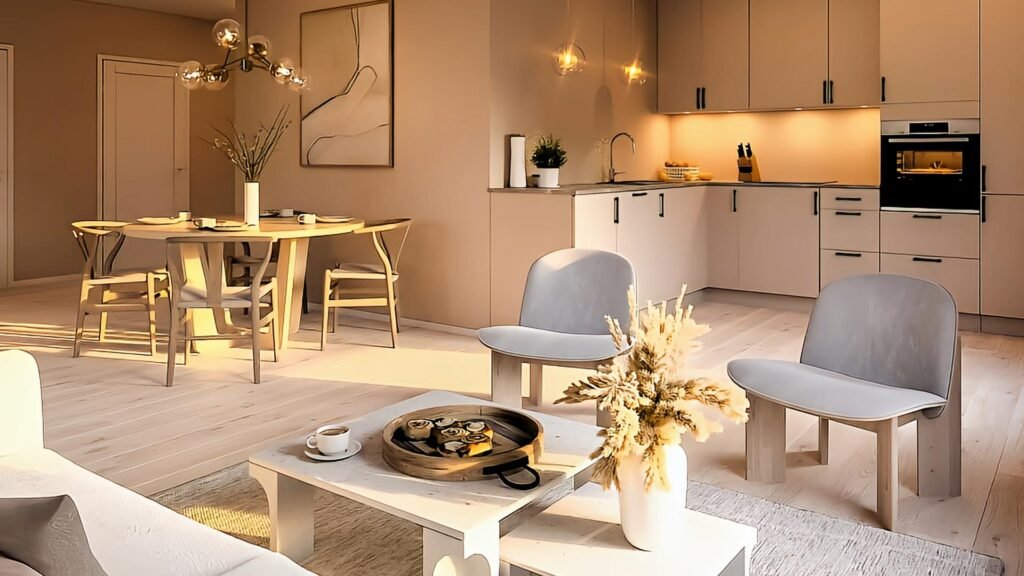Introduction to Calming Interiors
A calming interior is defined by a harmonious blend of elements that foster tranquility and serenity within a living space. Central to this aesthetic are the use of white, neutral tones, and natural wood. These materials and colors work in concert to create an environment that is peaceful, uncluttered, and soothing to the senses. In today’s fast-paced world, the importance of a serene home environment cannot be overstated. It is a sanctuary where one finds respite from the daily grind and stressors of modern life.

Psychological research has long highlighted the benefits of creating a calming space. White and neutral tones are known for their ability to make rooms feel airy, open, and larger than they are. They provide a clean canvas that reduces visual clutter, promoting mental clarity. Natural wood introduces a grounding element, evoking the tranquility of nature within the home. Together, these elements can significantly reduce stress and enhance relaxation, contributing to better overall well-being.
50 CALMING Interior Decor Solutions – White, Neutrals, and Natural Wood, #9
Please read our article watch the newly uploaded video from our YouTube channel:
“Grig Stamate – Interior Design Solutions”
https://www.youtube.com/@GrigStamate
50 CALMING Interior Decor Solutions – White, Neutrals, and Natural Wood, #9 (video)
Here, you can see other related videos from our channel:
50 CALMING Interior Decor Solutions – White, Neutrals, and Natural Wood, #8 (video)
50 CALMING Interior Decor Solutions – White, Neutrals, and Natural Wood, #7 (video)
The growing trend towards minimalist decor is a testament to the desire for tranquil living spaces. Minimalism emphasizes simplicity, functionality, and the intentional use of space. By paring down to the essentials, this design philosophy aims to create an environment that is free from distractions and excess. The result is a home that is both aesthetically pleasing and practically designed for relaxation and mental peace.
As we delve further into the article, we will explore various solutions to achieve calming interiors using white, neutrals, and natural wood. By understanding the impact of these design choices, homeowners can create sanctuaries that not only look beautiful but also nurture their mental and emotional health.
The Power of White in Interior Design
White is arguably one of the most versatile and powerful colors in interior design, capable of transforming spaces into havens of cleanliness, simplicity, and boundless expanse. The strategic use of white can amplify a room’s natural light, making it appear more extensive and inviting. This is particularly valuable in smaller spaces where the objective is to create a sense of openness.
There are various shades of white, each contributing uniquely to the ambiance of a room. Stark or pure white exudes modernity and crispness, perfect for minimalist designs. Off-whites and warmer whites with undertones of beige, yellow, or pink introduce a sense of coziness, making spaces feel more inviting. Cool whites with hints of blue or green can create a tranquil, calming environment.
Effectively using white in interior design extends beyond merely painting the walls. White furniture and accessories, like sofas, cabinets, and decorative pieces, can augment the sense of unity and spaciousness in a room. For instance, a white sectional couch can anchor a living room, while white kitchen cabinets can present a fresh, clean look.
However, an all-white decor can sometimes appear sterile and cold if not balanced correctly. Incorporating textures and natural elements is essential to prevent this issue. Introducing natural wood elements like exposed beams, wooden floors, and furniture can add warmth and an organic touch to the space. Textures in the form of soft throws, pillows, and area rugs can also inject comfort and depth.
Visual examples of effective white usage often showcase rooms with white walls balanced with wooden accents and textured furnishings. For example, a bright and airy bedroom may combine white walls and linens with a rustic wooden bed frame and a plush, woven rug. Living areas featuring white backdrops interspersed with greenery and natural fibers create a harmonious blend that feels both modern and inviting.
Ultimately, white’s power in interior design lies in its ability to adapt and enhance, making spaces feel cleaner, simpler, and more expansive. When thoughtfully paired with textures and natural elements, white can transform any room into a serene, well-balanced sanctuary.
Embracing Neutral Tones for a Harmonious Space
Neutral tones, including shades of beige, gray, and taupe, offer a timeless elegance and versatility that form the cornerstone of many harmonious interiors. When thoughtfully applied, these colors create a foundational backdrop that can complement an array of decor elements without overwhelming the senses, leading to a tranquil and balanced living space.
The beauty of a neutral palette lies in its ability to act as a blank canvas. Beige, for instance, brings warmth and a subtle richness, making it ideal for living rooms and bedrooms where comfort is paramount. Gray, on the other hand, introduces a cool sophistication, perfect for modern kitchens or bathrooms. Taupe seamlessly bridges the gap between the two, offering the best of both worlds with its balanced, earthy tone.
One of the significant benefits of using neutral tones is their unparalleled versatility. These shades can effortlessly blend with different styles, be it contemporary, traditional, or eclectic. They provide a sense of calm and stability, making spaces feel more organized and serene. Additionally, neutral colors are less likely to go out of style, ensuring your decor remains elegant and sophisticated for years to come.
To avoid a flat or monotonous appearance, consider layering different neutral shades within the same space. For example, pairing a soft gray sofa with taupe cushions and a beige throw can create layers of warmth and depth. Introducing patterns and textures is another effective way to add interest and dimension to a neutral palette. A herringbone-patterned rug, linen curtains with subtle stripes, or a textured wall panel can transform a simple room into a visually intriguing yet soothing haven.
In essence, the strategic use of neutral tones can convert any space into a serene retreat. Their innate ability to work well with various decor styles while maintaining a sense of balance and harmony makes them an indispensable tool in the realm of interior design.
Incorporating Natural Wood for Warmth and Texture
Natural wood plays a pivotal role in adding warmth, texture, and an organic feel to interior spaces. Its versatility allows it to seamlessly integrate into a variety of décor styles, from rustic to contemporary. The choice of wood can significantly influence the ambiance of a room, making it essential to understand the unique characteristics of different wood types.
Light-toned woods like pine and maple bring a sense of airiness to a space, making them ideal for smaller rooms or areas with limited natural light. Pine, with its distinct knots, lends a charming, rustic vibe, while maple offers a smoother, modern look. On the other end of the spectrum, rich woods such as walnut and mahogany introduce depth and luxury. Walnut, known for its dark, consistent grain, adds a sophisticated touch, whereas mahogany exudes timeless elegance with its reddish-brown hue.
Integrating natural wood into home interiors can be accomplished in a myriad of ways. Hardwood flooring is a popular choice, providing a durable and stylish foundation that complements various design elements. Wooden furniture, whether it is a striking dining table or a set of elegant chairs, anchors the room and fosters a welcoming atmosphere. Accent pieces like wooden shelves, picture frames, or even ceiling beams can further enhance the texture and character of the space.
Blending wood with other materials such as metal and stone creates a dynamic and balanced aesthetic. For instance, a wooden coffee table with sleek metal legs offers a compelling contrast, capturing both rustic charm and industrial edge. Stone countertops paired with wooden cabinetry in kitchens create a harmonious blend of natural elements, elevating the overall design to new heights.
As we continue to incorporate natural wood in interior décor, it is crucial to prioritize sustainability. Opting for eco-friendly wood options, such as reclaimed wood or wood certified by the Forest Stewardship Council (FSC), ensures that our design choices remain environmentally responsible. This approach not only supports the planet but also imbues interiors with unique, storied materials that enrich the overall aesthetic.
Other related posts from our website:
Let’s see here, three of them:
We also sincerely hope you like our ideas from this post, and you have also enjoyed our uploaded YouTube video.
See you next time at another article.
Thank you so much for your time. Bye now!



No Responses